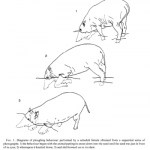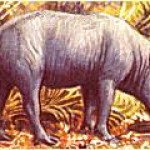Life Sciences
It's wonderful to see that my Open Letter to the Animal Liberation Front has generated discussion on this important topic. The issue as I see it is really quite simple and boils down to two essential issues: the benefits to science versus the ethics of invasive animal experimentation. The British Medical Journal study and BUAV report (pdf) that I cited hold the position that the harm done to animals, particularly primates, is out of proportion to the benefits that come from such research. Furthermore, our current understanding about primate cognition, emotional complexity, and their rich…
A few days ago I pointed to a paper which suggests the possible utility of looking at selection on standing genetic variation on quantitative traits to get a sense of the role of adaptation in the human genome. We humans like to think we're a complex species, so I see no a priori reason why our evolutionary history should be easily reducible to spare compact dynamics. Granted, we can start with the assumption that on the order of 50,000 years before the present there was a rapid demographic expansion of anatomically modern humans out of the continent of Africa. This story is simple, and is…
In the previous article we looked at the proposal that the various babirusa taxa - long regarded as subspecies - deserve to be raised to species rank. The argument goes that the taxa concerned are (1) morphologically diagnosable, (2) 'as distinct' as are other taxa traditionally regarded as species (raising the taxa to species level therefore represents a sort of attempt at uniformitarianism), and (3) represent distinct phylogenetic lineages. Meijaard & Groves's proposal therefore reflects their adherance to the phylogenetic species concept, or PSC (where distinct lineages on a…
On Laelaps, Brian Switek tells the story of a man who cooled off in an Ethiopian river against all advice, only to meet his death. Brian writes that "like our hominin forebears we can still be prey, and crocodiles are among the animals that have long considered us to be on the menu." Crocs were munching on our ancestors long before the pyramids rose along the Nile, and scientists have even named one ancient monstrosity Anthropophagus, the man-eater. Still, evidence for predation is slim, possibly because hominins who "fell prey to fully-grown crocodiles" were metabolized without a trace…
Male (right) and female (left, with infant) friends in a population of Chacma baboons. (From Palombit, 2009).
Among other things, friends are people you count on to come to your aid when you need help. If you were at a bar and a stranger started acting aggressively towards you, for example, you would expect your friends to rush over to help you rather than just stand there, mojito in hand. Contrary to our feelings of human exceptionalism, however, ours is not the only species of primate to create and maintain friendships.
For years primatologists have been puzzling over "friendship" in…
tags: humane society of the united states, HSUS, H$U$, Feld Entertainment, Ringling Bros. and Barnum & Bailey Circus, animal rights, animal welfare, lawsuit, Racketeer Influenced and Corrupt Organizations Act, RICO
In the United States on New Year's Eve, a judge dismissed a federal lawsuit filed by a consortium of animal rights groups including the Humane Society of the United States (HSUS). The lawsuit alleged that Feld Entertainment, the parent company of the Ringling Bros. and Barnum & Bailey Circus, mistreated elephants in violation of the Endangered Species Act. Now the Circus…
The IGF1 small dog haplotype is derived from Middle Eastern gray wolves:
Background
A selective sweep containing the insulin-like growth factor 1 (IGF1) gene is associated with size variation in domestic dogs. Intron 2 of IGF1 contains a SINE element and single nucleotide polymorphism (SNP) found in all small dog breeds that is almost entirely absent from large breeds. In this study, we surveyed a large sample of grey wolf populations to better understand the ancestral pattern of variation at IGF1 with a particular focus on the distribution of the small dog haplotype and its relationship to…
There are 31 new articles in PLoS ONE today. As always, you should rate the articles, post notes and comments and send trackbacks when you blog about the papers. You can now also easily place articles on various social services (CiteULike, Mendeley, Connotea, Stumbleupon, Facebook and Digg) with just one click. Here are my own picks for the week - you go and look for your own favourites:
A New Horned Crocodile from the Plio-Pleistocene Hominid Sites at Olduvai Gorge, Tanzania:
The fossil record reveals surprising crocodile diversity in the Neogene of Africa, but relationships with their…
Remember Dario Ringach?
He's the scientist who has endured a prolonged campaign of harassment because of his animal research. I first heard of him in 2006, when, after a campaign of threatening phone calls, people frightening his children, and demonstrations in front of his home, gave up doing primate research. Terrorism and intimidation worked, but who could blame Dr. Ringach? He was afraid for his family. That's because it was more than just threatening e-mails and phone calls, but rather the campaign of intimidation included masked thugs banging on the windows of his house at night,…
Way back in 2007, when I was still a neophyte science blogger, Rutgers University philosophy professor Jerry Fodor published an op-ed in the London Review of Books called "Why Pigs Don't Have Wings." It was a critique of a straw man version of evolutionary theory characterized by a brand of adaptationism so narrow that (if it were at all true) biologists could be charged with just making things up as they went along. But Fodor was not so much concerned with science as the extension of evolutionary ideas outside of biology. Motivated by his irritation with evolutionary psychology, a…
Being away at AAAS meeting also meant I did not have much time and opportunity until right now to check what's new in PLoS ONE yesterday and today. But I checked now, after coming back home. As always, you should rate the articles, post notes and comments and send trackbacks when you blog about the papers. You can now also easily place articles on various social services (CiteULike, Mendeley, Connotea, Stumbleupon, Facebook and Digg) with just one click. Here are my own picks for the week - you go and look for your own favourites:
An Investigation into the Cognition Behind Spontaneous…
Welcome to yet another article in the (outstandingly successful, yet recycled from ver 1) series on babirusas. Observant readers will have noticed that, strangely, I've refrained thus far from using a scientific binomial for babirusas, plus I've consistently (I think) referred to them in the plural, and not as a single species. What gives?
Well, the proverbial cat is already out of the bag, but the traditional taxonomy where all babirusas are referred to the single species Babyrousa babyrussa is now defunct and there are good reasons for recognising several species. Babirusa taxonomy was…
An assortment of tree-living mammals
In The Descent of Man, Darwin talked about the benefits of life among the treetops, citing the "power of quickly climbing trees, so as to escape from enemies". Around 140 years later, these benefits have been confirmed by Milena Shattuck and Scott Williams from the University of Illinois.
By looking at 776 species of mammals, they have found that on average, tree-dwellers live longer than their similarly sized land-lubbing counterparts. Animals that spend only part of their time in trees have lifespans that either lie somewhere between the two extremes or…
A restoration of the giant, durophagous shark Ptychodus, courtesy paleo-artist Matt Celeskey.
The study of prehistoric sharks is no easy task. Specialists in other branches of vertebrate paleontology at least have the reasonable hope of discovering complete skeletons of their subjects; except in instances of exceptional preservation the scientists who study sharks typically only have teeth and a few vertebrae to work with. Still, you can tell a lot about a shark by its teeth, and a new study published in Cretaceous Research suggests that one peculiar form was a shell-crushing giant.…
Whiptail lizards are a fairly ordinary-looking bunch, but some species are among the strangest animals around. You might not be able to work out why at first glance, but looking at their genes soon reveals their secret - they're all female, every single one. A third of whiptails have done away with males completely, a trick that only a small minority of animals have accomplished without going extinct.
Some readers might rejoice at the prospect of a world without males but in general, this isn't good news for a species. Sex has tremendous benefits. Every fling shuffles the genes of the two…
tags: Birdbooker Report, bird books, animal books, natural history books, ecology books
"How does one distinguish a truly civilized nation from an aggregation of
barbarians? That is easy. A civilized country produces much good bird
literature."
--Edgar Kincaid
The Birdbooker Report is a special weekly report of a wide variety of science, nature and behavior books that currently are, or soon will be available for purchase. This report is written by one of my Seattle birding pals and book collector, Ian "Birdbooker" Paulsen, and is edited by me and published here for your information and…
The bipedal 'boxing' behaviour of babirusas is odd, but arguably odder is a unique sort of 'ploughing' behaviour they've recently been shown to practise. On being presented with an area of soft sand, captive babirusas (mostly males) have been noted to kneel down and push their head and chest forward through the sand, the result being a deep furrow. One obscure report from the 1970s suggests that Sulawesi people associated babirusas with the creation of straight-line furrows. Possible babirusa furrows were reported from south-eastern Sulawesi in 2002, but this behaviour has otherwise gone…
Yup, traveling, but still manged to take a quick look at what's new in PLoS ONE today. As always, you should rate the articles, post notes and comments and send trackbacks when you blog about the papers. You can now also easily place articles on various social services (CiteULike, Mendeley, Connotea, Stumbleupon, Facebook and Digg) with just one click. Here are my own picks for the week - you go and look for your own favourites:
Novel Acoustic Technology for Studying Free-Ranging Shark Social Behaviour by Recording Individuals' Interactions:
Group behaviours are widespread among fish but…
Reuters and Bloomberg reported earlier this week on an ongoing patent battle (read: pissing match) between Pfizer and Eli Lilly & Co. relating to their erectile dysfunction drugs Viagra and Cialis, respectively.
A US Patent and Trademark Office (USPTO) appeals committee has ruled that an element of Pfizer's patent on sildenafil, the active chemical in Viagra, is invalid because the drug is insufficiently different from a traditional Chinese medicine called Yin Yang Huo or horny goat weed.
At issue is Pfizer's claim to a method for treating male erectile dysfunction. The patent appeals…
In the previous articles we looked at the distribution and phylogenetic position of babirusas, and also at a bit of their behaviour, biology and morphology. While babirusas are famous for the bizarre upper canines that emerge from the dorsal surface of the snout in males, the function of these teeth remains uncertain. As we saw in the previous article, it's been proposed that they function in display, in fighting, or in helping the animal to push its way through dense vegetation. The latter idea is least likely and is unsupported by observations. The fighting idea might seem logical and…




